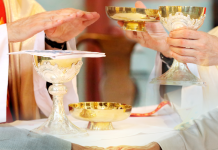
LEE DANESCO
There are few topics on any catechist’s teaching schedule more intimidating than the Trinity. You assume that trying to teach the unity of Father, Son, and Holy Spirit to eight-year-olds can only lead to catastrophe. You cringe at the thought.
Having served as a catechist for some time, you know that sharing the faith with children requires creativity, energy, and patience. But when you come face-to-face with the prospect of teaching the Trinity, you may also need the backup provided by a catechist-tested rule: “The more difficult the topic, the more simple the plan.”
A Simple Message
Effectively teaching the Trinity depends upon your willingness to simplify both what you plan to teach (message) and how you plan to teach it (management).
The catechist’s guide from your parish (if you have one) has already done much of the work for you. Skilled writers have conveniently framed the mystery of the Trinity with defining, descriptive, and age-appropriate terms. Additionally the guide will help you to erase and replace student misunderstandings with accurate, concise pinpointing of basic Church teaching.
Plan your lesson according to the guide. But dismiss your own teaching concerns by anchoring your message with a simple, stabilizing truth: Understand that when you begin your class, the Trinity will be a mystery of faith; accept that when you end your class, the Trinity will still be a mystery of faith.
It is not your teaching goal, nor is it within your power, to magically unravel or unveil the eternally mind-boggling mystery of the Trinity. Your task is only to lead students to appreciate the Trinity for what it is—a divine mystery, something wonderfully beyond all human comprehension.
When you humbly accept that limitation, your lesson immediately becomes much easier to manage.
Simple Management
Supplement the management tools found in your guide with exercises like the one below, which enables children to use human dimensions to glimpse divine truths.
Materials required: three individual or clustered sets of jingling bells (according to age group and instrument availability, you might substitute flutes, clarinets, human voices, etc.)
- Following children’s suggestions, designate each of the three bells as “Father,” “Son,” and “Holy Spirit,” and select student volunteers to ring each set of bells.
- Instruct students to listen carefully to the bells as they are rung separately, learning to identify the unique sound of each bell.
- Have children close their eyes. Direct individual ringers to sound a bell and then have children guess whether they are hearing Father, Son, or Holy Spirit.
- Then, while children remain with eyes closed, instruct ringers to ring their bells simultaneously. Inquire what that collective sound might represent. The answer is, of course, the Trinity—Father, Son, and Holy Spirit, blended together and ringing out in unity.
End the lesson by reminding students that while we cannot ever fully comprehend the mystery of the Trinity, God has given us the tools (some as simple as bells) to help explain more about that mystery.
The Catechism of the Catholic Church aptly defines the Trinity as “the central mystery of Christian faith and life” (CCC, 234). For catechists, how to teach children about the Trinity need not remain a mystery forever.
Lee Danesco is a former DRE and pastoral associate in Foxboro, Massachusetts.
This lesson is from the archives at Catechist.com.
Image Credit: Lordn / Shutterstock 755380093




